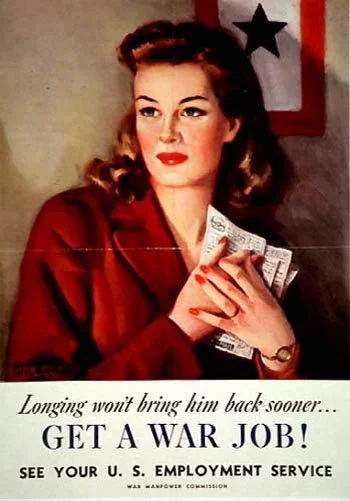277: How Do They Do That? Behind the Scenes at the Museum
“I was part of a large and extraordinarily talented team of curators and scholars. Pretty much everyone who's part of the New York Historical Society Center for Women's History contributed to this exhibition. And the other thing we could not have survived without was our amazing design team, the exhibition designers, and the graphic designers.”
— Jeanne Gutierrez
Guest
Jeanne Gutierrez is a Curatorial Scholar in Women's History at the New-York Historical Society. She is a Ph.D. candidate in History at the CUNY Graduate Center. Jeanne is the co-curator of the NYHS “Women’s Work” exhibit.
Summary
In this episode, Jeanne takes us behind the scenes at the New-York Historical Society to understand the collaborative thinking and effort that goes into curating a major museum exhibit, in this case, “Women’s Work.”
A World War II era poster encouraging women to get a job to support the war effort.
From the Museum’s exhibit program description:
“What is “women’s work?” How have broad trends in American economic, legal, and political history encouraged women to take certain jobs and restricted them from “men’s work?” How have race, ethnicity, social class, legal status, sexual orientation, and gender presentation impacted these distinctions? In a new exhibition, the Center for Women’s History showcases approximately 45 objects from New-York Historical’s own Museum and Library collections to demonstrate how “women’s work” defies categorization.”
Listen for:
• What story the curatorial staff is trying to tell about the nature of women’s work.
• Why collaboration between curators, scholars, and designers is essential.
• How the limited number of artifacts were selected and challenged the team.
• Why the staff had to limit the artifact captions to about 100 words.
• How the intentional organization and display of artifacts contribute to the story and visitor experience.
Social Media / Referenced
• https://www.nyhistory.org/
• Missionary Rag Baby, 1893–1910
Possibly Julia Jones Beecher (1826–1905)
Missionary Rag Baby, 1893–1910
Stockinette, cotton, yarn, paper, paint
New-York Historical Society, Gift of Helen Graham Fairbank Goodkin, 2022.16
In 1893, Julia Jones Beecher—sister-in-law to author Harriet Beecher Stowe—began upcycling used stockings to create dolls such as this one. They were sold at charitable functions nationwide to raise money for the missionary work sponsored by the abolitionist Independent Congregational Church in Elmira, New York, where her husband preached and she played a prominent role in the daily operations and fundraising efforts. Beecher and the women’s sewing circle she enlisted raised over $1,000 within two years.
A prominent brow, painted eyes, and curly yarn hair are all characteristic of the “Beecher-type” doll. Made using a stuffed stocking, this example is distinct from other Beecher-type dolls because of its racialized design. While the women of Park Congregational Church created white dolls depicting babies, their Black dolls portrayed adult women, often adorned with an apron. This pattern reflects the “mammy” caricature: a cheerfully subservient black female figure ready to perform domestic work and care for white children that was found throughout American visual culture in the 1800s and 1900s.
The funds raised by the Elmira Independent Congregational Church women's sewing circle helped support both foreign and "home" missionary work, which included sending aid to a freedmen's school in Alabama. Although federal support for formerly enslaved people largely ended during the 1870s, charitable organizations continued to send money and teachers to support African American education in the South, working to undo the legacy of state laws that forbid the enslaved from learning to read or write.
About Jeff
Jeff Ikler is the Director of Quetico Leadership and Career Coaching. “Quetico” (KWEH-teh-co). He works with leaders in all aspects of life to identify and overcome obstacles in their desired future. He came to the field of coaching after a 35-year career in educational publishing. Prior to his career in educational publishing, Jeff taught high school U.S. history and government.
Jeff has hosted the “Getting Unstuck—Cultivating Curiosity” podcast for 5 years. The guests and topics he explores are designed to help listeners think differently about the familiar and welcome the new as something to consider. He is also the co-host of the Cultivating Resilience – A Whole Community Approach to Alleviating Trauma in Schools, which promotes mental health and overall wellness.
Jeff co-authored Shifting: How School Leaders Can Create a Culture of Change. Shifting integrates leadership development and change mechanics in a three-part change framework to help guide school leaders and their teams toward productive change.
Show Credits
"Getting Unstuck" is commercial-free. It’s brought to you by Jeff Ikler, his amazing guests, and Neil Hughes, the best engineer a podcaster could ask for.
"Getting Unstuck" theme music: Original composition of "Allegro ben ritmato e deciso" by George Gershwin. Arrangement and recording courtesy of Bruno Lecoeur.







